The high-power fast charging of the pure electric passenger car is to use high voltage and large current to fully charge the electric car in a short time. The realization of this function largely determines the convenience of using the car. At present, fast charging and long driving mileage are the two most urgent needs of pure electric passenger car users. In terms of high-power fast charging, the goal of its function realization will have a great impact on the product design of electric vehicles. This article will start some discussion on this.
Before we start, we will divide the relevant layers into two parts: the vehicle end (EV) and the charging supply end (EVSE). At the charging supply end, the enterprise correlation method can be subdivided into local power grid (grid load management), charging operator, charging facility integrator, charging module integrator, charging connector and cable supplier. On the vehicle side, from the enterprise can be divided into vehicle OEM companies, battery system suppliers, battery cooling / heating subsystem suppliers, charging connectors and cable suppliers, car charger suppliers, drive system suppliers, electricity Air conditioning suppliers and DCDC suppliers as well as high voltage electrical system suppliers and so on.
The following is a discussion on the development prospects of high-power fast charging of electric passenger cars from the perspectives of the current situation, demand, technical conditions and challenges of the charging supply end and the vehicle end.
It is worth noting that at the end of last year, Daimler, BMW, Flowserve, Ford and other four major automakers announced that they will jointly deploy an "ultra-fast charging station" for electric vehicles in Europe. It is estimated that 400 charging stations will be set up as joint charging systems. (CCS) with a maximum power of 350kW. This event indicates that the OEMs are co-locating high-power fast charging to improve the consumer experience.

Figure 1 The impact of high power fast charge changes
First, the charging supply end
1) Systematic consideration from the grid
The grid is the source of charging. Considering the stability of the grid operation, the local grid hopes that the load of the electric vehicle should not be too fast, because the access of a single point of great load will definitely impose a great burden on the grid. The security also poses a serious challenge, which directly sets the tone. If considered from the overall planning of the power grid, high-power fast charging will greatly reduce the possibility of orderly charging, resulting in an increase in the peak-to-valley difference of the grid load and reducing the overall input-output efficiency of the large power grid.
· Opened a fast charging station, the user's expectation of charging speed will become faster, it is easy to appear like queuing charging phenomenon like queuing. In the peak of commuting, load management is a big problem, because the charging starts, the grid The load will go up at once, and all the charging will occur. Similarly, after the fast charging is completed, the charging will stop at the same time.
· Under the existing control mode, the above situation is deduced, and the local distribution load change will reach 20% or even higher than the load of the connected transformer. In the period of tight power supply such as summer, the overload problem is easy to occur. Line overheating, tripping, etc., will cause a large amount of load on the grid to be removed.
· From the perspective of the time axis, due to the mobile characteristics of the vehicle, the difficulty of the existing load management will be aggravated. Under the influence of holidays, climate change, major events and other factors, especially in the event of a chain accident, the possibility of occurrence of a problem is very high.
Since the layout of high-power charging is close to private consumers, the charging facility operators will consider the actual demand rather than the grid. Fast-filled and fast-fill stations will be widely distributed in residential areas, office areas, and consumption. District and industrial area. Such a layout can easily affect the stability of commercial power. What happens if the grid is required to claim? The same is true in the industrial zone. How does the introduction of a large-scale power appliance affect the stability of the power supply and cause the loss of industrial production?
2) Angle of the charging facility
Promote alliance data according to charging facilities. As of April 2017, the member units in the alliance reported a total of 161,193 public charging piles, including 55,956 AC charging piles, 39,163 DC charging piles, and 66,074 AC and DC charging piles. According to this data, the utilization rate of 100,000 DC charging piles (30~60kW) is a problem. According to this data, the actual total investment is not small for so many charging piles, but the utilization rate from the charging facilities. In terms of the satisfaction rate of private users' fast charge and the power consumption of unit charging piles, there is no particularly good match between input and payment, which objectively pushes the charging facility operator into a very difficult situation.
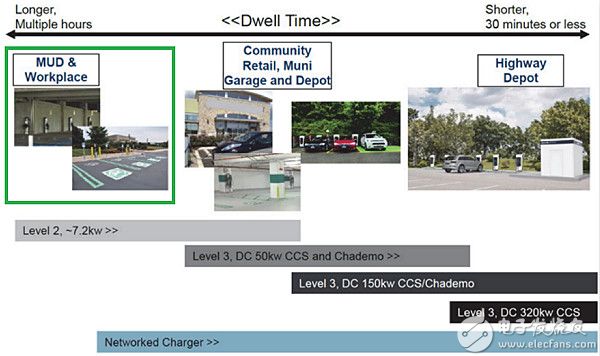
Figure 2 Existing fast charging power and application scenarios
From the application scenario, 350kW is a long-term consideration. In China, the following types of requirements are more urgent:
· The core areas of first-tier cities such as Beijing, Shanghai, Shenzhen, etc., under the condition of less parking resources, high-power fast charging is extremely demanding;
· Taxi/time-sharing: There is a requirement for the speed of replenishment, and it is also a recognition of the time value of fast charging.
· On the highway, the area where the operation is required
At present, the revenue of the charging operator depends on the charging service fee and the charging electricity fee. If the consumer has a shorter demand for the charging time, and the actual charging service cannot satisfy the demand, the actual revenue of the charging operation is not High. If you develop rapidly, you can effectively compare the operation of fast charging stations with operating gas stations. If the supply of vehicles can reach a certain amount, the charging facility operators will not hesitate to keep up with this trend. With the standard draft of the "Electric Vehicle Flexible Reactor" and the upgrading of the product concept, the design considerations of the charging facility and the charging module are also arranged in a centralized manner, so that a certain power sharing can be realized in different charging terminals. As mentioned above, it is relatively easy to keep up with the trend of high-power fast charging in the process of continuous maintenance and future upgrades of DC charging piles.
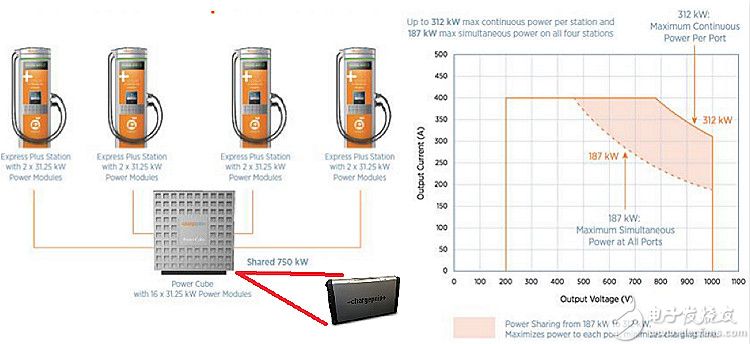
Figure 3 Power scheduling of the charging reactor is a very common trend
3) Technical details
At the seminar "The Prospects and Challenges of High-Power Charging Technology for Electric Passenger Cars" held recently, several issues that everyone is communicating are worth exploring:
· Charge voltage problem: There is a relatively low efficiency end in 200V~1000V. The output voltage design of the charging module needs to match the voltage platform of the electric vehicle. The charging module needs to meet the vehicles on the market, and the voltage preferred end still needs some consensus between the vehicle enterprise and the charging terminal.
· Charging interface and cable: The problem here is relatively large. Due to the reality, security and compatibility requirements are placed in the first two of all problems. When the GBT series standard goes in the direction of 350kW, how to improve the interface, protocol, interface & cable cooling, etc. is the key to the realization of fast charging function. In this regard, in fact, domestic standard setters have begun to lay out in advance, and the preparatory working group follows the rules of IEC/ISO standards. The concept is first produced, the samples are produced, and after careful verification, the reliable standards are formed, and then pushed down.
In terms of the development trend of vehicle electrification, China's future in Asia, especially in Southeast Asia, is highly likely, and the export of integrated charging facilities to Southeast Asia is inevitable. With the charging module and related equipment, it is quite meaningful to challenge the European and American markets. The car can't be sold and the charging facilities are sold. As shown in the figure below, the number of LEAFs in the United States is 100,000, and there are only 5,000 DC charging piles. The gap is not small.

Figure 4 Ratio of LEAF and Chademo DC charging piles
The second part of the vehicle end
For electric vehicles, our primary consideration is whether the future development of electrified vehicles will follow the expected direction.
1) Development trend of electric vehicles
· Since 2017, the decline in subsidies has made A00-class electric vehicles a reality. In Beijing, such low-priced vehicles are regarded as “accounting†artifacts. At the same time, we need to consider whether this development trend is Persistent. It’s not a joke to say, wait for the right electric vehicle to come out and give you a check in minutes...
· From a global perspective, the battery capacity of pure electric vehicles ranges from 20kwh to 30~40kwh to 50~80kwh. The driving range from 80~100 miles to 150 miles and then to 200~300 miles is also a clear trend. .
Considering the cycle of vehicle development, the whole vehicle enterprise will raise 350kW for future car considerations, and promote high-power fast charging. It is also because the future electric vehicles (battery impulse 60kwh or more) can be charged with 3.3 and 6.6kW charging power. For consumers, the charging speed is too slow, and there will be cases where the home is not fully charged, so the consumption experience will be worse.
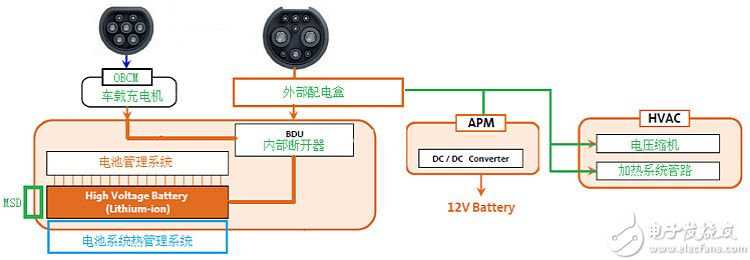
Figure 5 charging related unit
2) Existing charging speed and power
Looking at the two cars with a current battery capacity of 30kwh, the normal charging power is between 40~50kW. At a normal temperature of 25 degrees, depending on the inflection point of the different SOC of the battery chemical system, the derating of the charging power is different at different temperatures.
As far as the development trend is concerned, the fast charging characteristics of the single unit are in the first place, and the core is still in the narrow temperature range to verify the influence of the fast charging cycle characteristics on the capacity and internal resistance; in the modularization and Pack grouping In the process of controlling the external environment temperature and temperature rise, it also puts forward requirements for the difference.
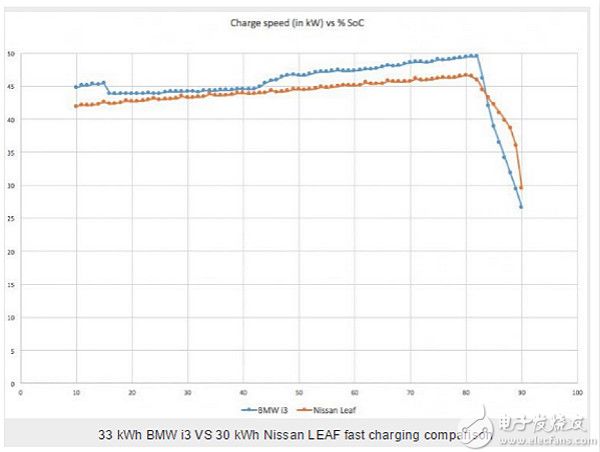
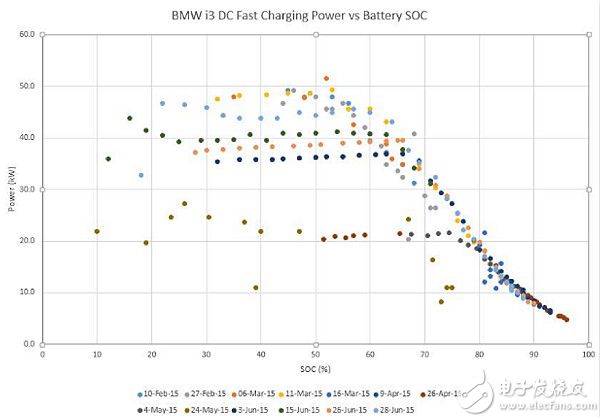
Figure 6 30kWh charging power vs SOC
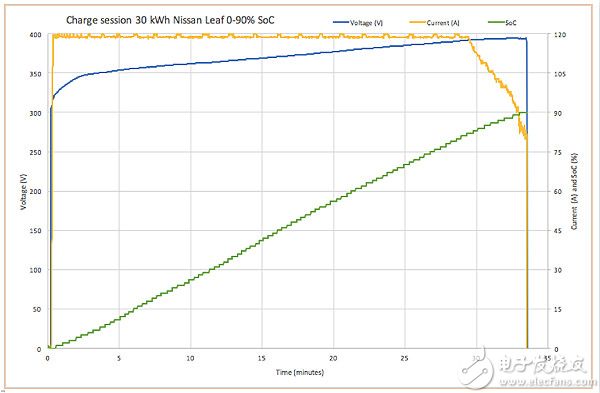
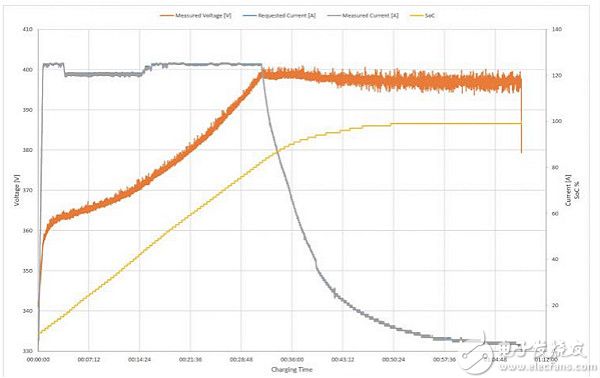
Figure 7 Existing charging curve
Then, as the capacity of the battery system becomes larger, it is worthwhile to explore the parallel connection of a larger capacity battery at the battery level under the existing voltage platform, or to connect more in the direction of high voltage.
· From the perspective of voltage level improvement, in fact, in the high-power fast charging circuit, the current and voltage are improved. The use of high-voltage and high-power charging system needs to improve the performance of the battery system and the power distribution system;
·In terms of power electronics, the core is high-voltage power devices. At present, the passenger car industry has not yet popularized high-voltage and high-power devices. Because of its high cost and reliability, the relevant laws and regulations and test standards are not yet perfect. .
Advances in materials and devices will inevitably have a profound impact on the design of the entire part and the characteristics of the part. Therefore, in the process of electrification of automotive OEMs in the future, it is necessary to integrate global resources and penetrate into the fields of components, devices and materials to occupy advanced technology and time advantages. This is unstoppable, but it is said that at this stage there is no way to take these research and reserve technologies directly as mass production vehicles for sale.
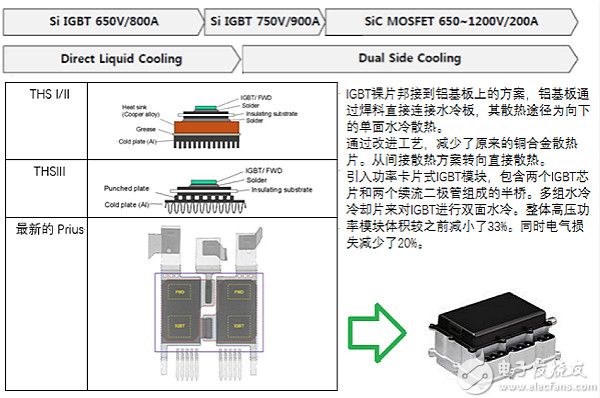
Third, summary and recommendations:
To understand the development of high-power fast charging for electric passenger cars, we must also consider it into the development pattern of the entire electric passenger vehicle industry:
First, the subsidy policy, the whitelist policy, the different GBT standards and the certification process actually bring a development window to the domestic new energy vehicles. The strategy of relatively negative mixed behavior can also be understood as a tactical Measures. Even if the policy is not subsidized, Toyota's hybrid development is very rapid in China. Without it, the product technology itself has great advantages. These measures cannot limit the real and simple needs of consumers.
Second, in the development of the characteristics of materials, devices and components, the threshold of pure electric vehicles will naturally rise; in the field of three electricity, in the field of use (charging characteristics and intelligent field), after a little systematic accumulation In the future, when a large number of resources are integrated and developed (2020~2025), what kind of pure electric vehicles will develop, only by the existing technology, there will be a big error.
Third, the current Chinese new energy automobile industry has certain systemic risks. That is, when local enterprises have “fence protectionâ€, they enjoy the benefits of cash subsidies and the number one honor in the world, but they do not see the real The opponents are also squatting and waiting for the fence. After a few waves of government and domestic companies have completed the consumer education and matured the market, the real opponents will bring you different products. It is. At that time, "When they go low, we go high", this is really a feeling of embarrassment.
Suggest:
1) Charging connector and high-power charging technology layer, to fully participate in and trial production of samples, after testing and verification, establish a version of the passenger car can be really used, and can be pushed to Asia (Southeast Asia and Australia are following the influence in the standard world) Big standards come to go) national standards and products.
In the battery system layer, it is necessary to decompose the special requirements of thermal management brought by high-power charging, and then fully reduce the fast charging characteristics of the single cell at the battery system level; for the control characteristics of the charging module, it needs to be defined and limited, if the current is large To the point of current limiting, but the limitation will have a big impact on the battery
Power electronics layer (car charger and DC-DC), SiC MOSFET has many applications in China, not a big problem, the core difficulty is still in the power module of the main inverter, with many domestic enterprises investing in this In a field, related trial production can still be done.
Phone Accessories,Smartphone Holder,Cell Phone Stand Holder,Adjustable Stand Holder
Shaoxing Shangyu Kenuo Photographic Equipment Factory , https://www.kernelphoto.com